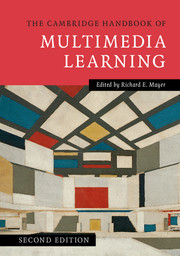Book contents
- The Cambridge Handbook of Multimedia Learning
- The Cambridge Handbook of Multimedia Learning
- Copyright page
- Contents
- Contributors
- Preface
- Acknowledgments
- 1 Introduction to Multimedia Learning
- Part I Theoretical Foundations
- Part II Basic Principles of Multimedia Learning
- Part III Advanced Principles of Multimedia Learning
- Part IV Multimedia Learning of Cognitive Processes
- Part V Multimedia Learning in Advanced Computer-Based Contexts
- 29 Multimedia Learning with Intelligent Tutoring Systems
- 30 Multimedia Learning with Simulations and Microworlds
- 31 Multimedia Learning with Computer Games
- 32 Multimedia Learning with Video
- 33 Multimedia Learning from Multiple Documents
- 34 Multimedia Learning in e-Courses
- Author Index
- Subject Index
32 - Multimedia Learning with Video
from Part V - Multimedia Learning in Advanced Computer-Based Contexts
Published online by Cambridge University Press: 05 August 2014
- The Cambridge Handbook of Multimedia Learning
- The Cambridge Handbook of Multimedia Learning
- Copyright page
- Contents
- Contributors
- Preface
- Acknowledgments
- 1 Introduction to Multimedia Learning
- Part I Theoretical Foundations
- Part II Basic Principles of Multimedia Learning
- Part III Advanced Principles of Multimedia Learning
- Part IV Multimedia Learning of Cognitive Processes
- Part V Multimedia Learning in Advanced Computer-Based Contexts
- 29 Multimedia Learning with Intelligent Tutoring Systems
- 30 Multimedia Learning with Simulations and Microworlds
- 31 Multimedia Learning with Computer Games
- 32 Multimedia Learning with Video
- 33 Multimedia Learning from Multiple Documents
- 34 Multimedia Learning in e-Courses
- Author Index
- Subject Index
Summary
This chapter on multimedia learning with video focuses on what and how teachers learn from interacting socially with one another while viewing and analyzing videos of classrooms, an emphasis motivated by the emergence of popular practices that use video in the professional development of teachers and by the widespread assumption that video used in socially situated instructional settings is a valuable resource for teacher learning. We discuss examples of well-known approaches to video-based teacher learning, suggesting several dimensions along which these types of environments might be varied in instructional research. We then suggest two basic levels at which to measure learning outcomes: the individual level, that is, what and how individuals learn as they interact with video over time; and the system level, that is, how learning reflects changes in the way groups of viewers use and learn from video over time. Finally, we examine the role that cognitively based multimedia theory might play in guiding design of and research on video-based learning environments for teachers, concluding that it does indeed have much to offer work in this field.
Keywords
- Type
- Chapter
- Information
- The Cambridge Handbook of Multimedia Learning , pp. 785 - 812Publisher: Cambridge University PressPrint publication year: 2014
- 22
- Cited by

